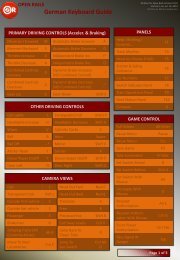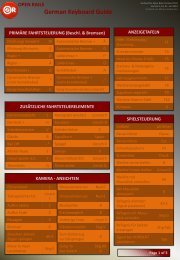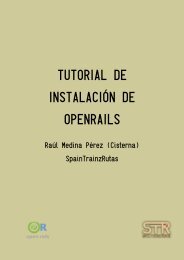Operations Manual - Open Rails
Operations Manual - Open Rails
Operations Manual - Open Rails
Create successful ePaper yourself
Turn your PDF publications into a flip-book with our unique Google optimized e-Paper software.
press Period (.) and Comma (,) to decrease them. Initially dynamic brakes are off, the throttle<br />
works and there is no dynamic brake line in the HUD. To turn on dynamic brakes set the throttle<br />
to zero and then press Period, this will add a dynamic brake line to the HUD. Pressing Period<br />
successive times increases the Dynamic braking forces. To turn off the Dynamic brakes press<br />
Comma after setting the brakes to 0%. The throttle will not work when the Dynamic brakes are<br />
on.<br />
The Dynamic brake force as a function of control setting and speed can be defined in a<br />
DynamicBrakeForceCurves table that works like the MaxTractiveForceCurves table. If there is<br />
no DynamicBrakeForceCurves defined in the ENG file, than one is created based on the MSTS<br />
parameter values.<br />
Dynamic brake sounds have not been implemented at this time.<br />
A Glimpse of the Future<br />
Proprietary <strong>Open</strong> <strong>Rails</strong> Braking Parameters – File Inclusions for ENG files<br />
<strong>Open</strong> <strong>Rails</strong> has implemented additional specific braking parameters to deliver realism in braking<br />
performance in the sim.<br />
The <strong>Open</strong> <strong>Rails</strong> team intends to provide separate documentation detailing the<br />
usage, syntax, and methodology of how to use these new braking and performance<br />
parameters. Check the <strong>Open</strong> <strong>Rails</strong> web site periodically for current status.<br />
Following are a list of specific OR parameters and their default values. The default values are<br />
used in place of MSTS braking parameters; however, two MSTS parameters are used for the<br />
release state: MaxAuxilaryChargingRate and EmergencyResChargingRate<br />
wagon(brakepipevolume - Volume of car's brake pipe in cubic feet (default .5). This is<br />
dependent on the train length calculated from the ENG to the last car in the train. This<br />
aggregate factor is used to approximate the effects of train length on other factors.<br />
Strictly speaking this value should depend on the car length, but the <strong>Open</strong> <strong>Rails</strong><br />
Development team doesn’t believe it’s worth the extra complication or CPU time that would be<br />
needed to calculate it in real time. We will let the community customize this effect by adjusting<br />
the brake servicetimefactor instead, but the <strong>Open</strong> <strong>Rails</strong> Development team doesn’t believe this<br />
is worth the effort by the user for the added realism.<br />
engine(mainreschargingrate - Rate of main reservoir pressure change in PSI per second when<br />
the compressor is on (default .4).<br />
engine(enginebrakereleaserate - Rate of engine brake pressure decrease in PSI per second<br />
(default 12.5).<br />
engine(enginebrakeapplicationrate - Rate of engine brake pressure increase in PSI per second<br />
33






